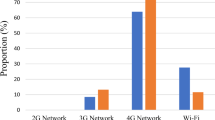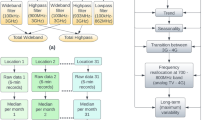Abstract
The increase in mobile communication technology has led to concern about potential health effects of radio frequency electromagnetic fields (RF-EMFs) from mobile phone base stations. Different RF-EMF prediction models have been applied to assess population exposure to RF-EMF. Our study examines what input data are needed to accurately model RF-EMF, as detailed data are not always available for epidemiological studies. We used NISMap, a 3D radio wave propagation model, to test models with various levels of detail in building and antenna input data. The model outcomes were compared with outdoor measurements taken in Amsterdam, the Netherlands. Results showed good agreement between modelled and measured RF-EMF when 3D building data and basic antenna information (location, height, frequency and direction) were used: Spearman correlations were >0.6. Model performance was not sensitive to changes in building damping parameters. Antenna-specific information about down-tilt, type and output power did not significantly improve model performance compared with using average down-tilt and power values, or assuming one standard antenna type. We conclude that 3D radio wave propagation modelling is a feasible approach to predict outdoor RF-EMF levels for ranking exposure levels in epidemiological studies, when 3D building data and information on the antenna height, frequency, location and direction are available.
This is a preview of subscription content, access via your institution
Access options
Subscribe to this journal
Receive 6 print issues and online access
$259.00 per year
only $43.17 per issue
Buy this article
- Purchase on Springer Link
- Instant access to full article PDF
Prices may be subject to local taxes which are calculated during checkout

Similar content being viewed by others
References
Frei P, Mohler E, Neubauer G, Theis G, Bürgi A, Fröhlich J et al. Temporal and spatial variability of personal exposure to radio frequency electromagnetic fields. Environ Res 2009; 109: 779–785.
Thomas S, Kuhnlein A, Heinrich S, Praml G, Nowak D, von Kries R et al. Personal exposure to mobile phone frequencies and well-being in adults: a cross-sectional study based on dosimetry. Bioelectromagnetics 2008; 29: 463–470.
Bolte JF, Eikelboom T . Personal radiofrequency electromagnetic field measurements in The Netherlands: exposure level and variability for everyday activities, times of day and types of area. Environ Int 2012; 48: 133–142.
Viel JF, Cardis E, Moissonnier M, de Seze R, Hours M . Radiofrequency exposure in the French general population: band, time, location and activity variability. Environ Int 2009; 35: 1150–1154.
Li CY, Liu CC, Chang YH, Chou LP, Ko MC . A population-based case-control study of radiofrequency exposure in relation to childhood neoplasm. Sci Total Environ 2012; 435-436C: 472–478.
Eskander EF, Estefan SF, Abd-Rabou AA . How does long term exposure to base stations and mobile phones affect human hormone profiles? Clin Biochem 2012; 45: 157–161.
Dode AC, Leao MM, Tejo Fde A, Gomes AC, Dode DC, Dode MC et al. Mortality by neoplasia and cellular telephone base stations in the Belo Horizonte municipality, Minas Gerais state. Brazil. Sci Total Environ 2011; 409: 3649–3665.
Frei P, Mohler E, Bürgi A, Fröhlich J, Neubauer G, Braun-Fahrländer C et al. Classification of personal exposure to radio frequency electromagnetic fields (RF-EMF) for epidemiological research: evaluation of different exposure assessment methods. Environ Int 2010; 36: 714–720.
Anglesio L, Benedetto A, Bonino A, Colla D, Martire F, Saudino Fusette S et al. Population exposure to electromagnetic fields generated by radio base stations: evaluation of the urban background by using provisional model and instrumental measurements. Radiat Prot Dosimetry 2001; 97: 355–358.
Neitzke HP, Osterhoff J, Peklo K, Voigt H . Determination of exposure due to mobile phone base stations in an epidemiological study. Radiat Prot Dosimetry 2007; 124: 35–39.
Breckenkamp J, Neitzke HP, Bornkessel C, Berg-Beckhoff G . Applicability of an exposure model for the determination of emissions from mobile phone base stations. Radiat Prot Dosimetry 2008; 131: 474–481.
Briggs D, Beale L, Bennett J, Toledano MB, de Hoogh K . A geographical model of radio-frequency power density around mobile phone masts. Sci Total Environ 2012; 426: 233–243.
Bürgi A, Theis G, Siegenthaler A, Röösli M . Exposure modeling of high-frequency electromagnetic fields. J Expo Sci Environ Epidemiol 2008; 18: 183–191.
Bürgi A, Frei P, Theis G, Mohler E, Braun-Fahrlander C, Frohlich J et al. A model for radiofrequency electromagnetic field predictions at outdoor and indoor locations in the context of epidemiological research. Bioelectromagnetics 2010; 31: 226–236.
Beekhuizen J, Vermeulen R, Kromhout H, Bürgi A, Huss A . Geospatial modelling of electromagnetic fields from mobile phone base stations. Sci Total Environ 2013 2/15 445–446: 202–209.
ITU. ITU-R P.1411-5: Propagation data and prediction methods for the planning of short-range outdoor radiocommunication systems and radio local area networks in the frequency range 300 MHz to 100 GHz, 2009. International Telecommunication Union: Geneva.
Lauer O, Neubauer G, Roosli M, Riederer M, Frei P, Mohler E et al. Measurement setup and protocol for characterizing and testing radio frequency personal exposure meters. Bioelectromagnetics 2012; 33: 75–85.
Berg JE . Building penetration. In: Damosso E (ed). COST Telecommunications—Digital Mobile Radio Towards Future Generation Systems, Final Report. European Communities: Luxemburg. 1999 pp 167–174.
Elliott P, Toledano MB, Bennett J, Beale L, de Hoogh K, Best N et al. Mobile phone base stations and early childhood cancers: case-control study. BMJ 2010; 340: c3077.
Acknowledgements
This work was supported by The Netherlands Organization for Health Research (ZonMW) within the program Electromagnetic Fields and Health Research under grant numbers 85800001, 85500008, 85500011 and 85500017. We thank the Dutch network operators for providing us with detailed data about all mobile phone base station antennas in Amsterdam, and Jürg Fröhlich, Oliver Lauer and Marco Zahner from ETH Zürich for the accuracy tests of the EME-SPY 140 measurement devices, and Aidan Noorman for performing the measurements.
Author information
Authors and Affiliations
Corresponding author
Ethics declarations
Competing interests
The authors declare no conflict of interest.
Rights and permissions
About this article
Cite this article
Beekhuizen, J., Kromhout, H., Bürgi, A. et al. What input data are needed to accurately model electromagnetic fields from mobile phone base stations?. J Expo Sci Environ Epidemiol 25, 53–57 (2015). https://doi.org/10.1038/jes.2014.1
Received:
Accepted:
Published:
Issue Date:
DOI: https://doi.org/10.1038/jes.2014.1
Keywords
This article is cited by
-
Spatial variability of outdoor exposure to radiofrequency radiation from mobile phone base stations, in Khartoum, Sudan
Environmental Science and Pollution Research (2022)
-
Radiofrequency electromagnetic field exposure assessment: a pilot study on mobile phone signal strength and transmitted power levels
Journal of Exposure Science & Environmental Epidemiology (2021)
-
Radiofrequency electromagnetic field exposure in everyday microenvironments in Europe: A systematic literature review
Journal of Exposure Science & Environmental Epidemiology (2018)



